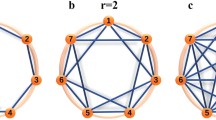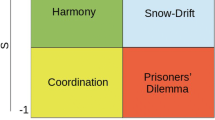Abstract
We show that a matrix game within groups in a finite-island model is effectively equivalent to a matrix game in a well-mixed population. The effective game matrix is a sum of interaction effects minus competition effects, weighted by identity measures involving up to three individuals. These identity measures are computed in the absence of selection but depend on the selection regime and the dispersal pattern: differential viability or fertility, hard selection or soft selection, uniform dispersal or local extinction followed by uniform recolonization. Hard selection, which allows for group selection, understood as differential contributions of groups, reduces competition within groups compared to soft selection. Moreover, the reduction is more pronounced in the case of uniform dispersal than in the case of local extinction. Fertility differences add competition effects between an individual and itself. A personal inclusive payoff can be defined from the effective game matrix and used to predict the increase or decrease in frequency of a mutant strategy. However, this personal inclusive payoff is generally frequency-dependent and its mean does not necessarily increase over time.
Similar content being viewed by others
References
Antal T, Ohtsuki H, Wakeley J, Taylor PD, Nowak MA (2009) Proc Natl Acad Sci USA 106:8597–8600
Aoki K (1982) A condition for group selection to prevail over counteracting individual selection. Evolution 36:832–842
Boorman S, Levitt PR (1980) The genetics of altruism. Academic Press, New York
Christiansen F (1975) Hard and soft selection in a subdivided population. Am Nat 109:11–16
Ewens WJ (1972) The sampling theory of selectively neutral alleles. Theor Popul Biol 3:87–112
Ferrière R, Michod RE (1980) The evolution of cooperation in spatially heterogeneous populations. Am Nat 147:692–717
Fisher RA (1930) The genetical theory of natural selection. Clarendon, Oxford
Grafen A (1985) A geometric view of relatedness. Oxf Surv Evol Biol 2:28–89
Hamilton WD (1964) The genetical evolution of social behaviour I and II. J Theor Biol 7:1–52
Hauert C, Doebeli M (2004) Spatial structure often inhibits the evolution of cooperation in the snowdrift game. Nature 428:643–646
Hilbe C (2011) Local replicator dynamics: a simple link between deterministic and stochastic models of evolutionary game theory. Bull Math Biol, doi:10.1007/s11538-010-9608-2
Hofbauer J, Sigmund K (1998) Evolutionary games and population dynamics. Cambridge University Press, Cambridge
Hofbauer J, Sigmund K (2003) Evolutionary game dynamics. Bull Am Math Soc 40:479–519
Kingman JFC (1982) The coalescent. Stoch Process Appl 13:235–248
Lessard S (1992) Relatedness and inclusive fitness with inbreeding. Theor Popul Biol 42:284–307
Lessard S (2005) Long-term stability from fixation probabilities in finite populations: new perspectives for ESS theory. Theor Popul Biol 68:19–27
Lessard S (2009) Diffusion approximations for one-locus multi-allele kin selection, mutation and random drift in group-structured populations: a unifying approach to selection models in population genetics. J Math Biol 59:659–696
Lessard S, Ladret V (2007) The probability of fixation of a single mutant in an exchangeable selection model. J Math Biol 54:721–744
Lessard S, Rocheleau G (2004) Kin selection and coefficients of relatedness in family-structured populations with inbreeding. Theor Popul Biol 66:287–306
Levins R (1970) Extinction. In: Gerstenhaber M (ed) Some mathematical questions in biology. Lectures on mathematics in the life sciences, vol 2. Am Math Soc, Providence, pp 75–107
Lewontin RC (1965) Selection in and of populations. In: Moore JA (ed) Ideas in modern biology. Natural History Press, New York, pp 292–311
Maynard Smith J (1964) Group selection and kin selection. Nature 201:1145–1147
Michod RE, Hamilton WD (1980) Coefficients of relatedness in sociobiology. Nature 288:694–697
Nowak MA, Tarnita CE, Antal T (2010a) Evolutionary dynamics in structured populations. Philos Trans R Soc Lond B, Biol Sci 365:19–30
Nowak MA, Tarnita CE, Wilson EO (2010b) The evolution of eusociality. Nature 466:1057–1062
Ohtsuki H, Hauert C, Lieberman E, Nowak MA (2006) A simple rule for the evolution of cooperation on graphs and social networks. Nature 441:502–505
Price GR (1970) Selection and covariance. Nature (London) 227:520–521
Price GR (1972) Extension of covariance selection mathematics. Am Hum Genet, London 35:485–490
Rousset F (2006) Separation of time scales, fixation probabilities and convergence to evolutionarily stable states under isolation by distance. Theor Popul Biol 69:165–179
Rousset F, Billiard S (2000) A theoretical basis for measures of kin selection in subdivided populations: finite populations and localized dispersal. J Evol Biol 13:814–825
Roze D, Rousset F (2003) Selection and drift in subdivided populations: a straightforward method for deriving diffusion approximations and applications involving dominance, selfing and local extinctions. Genetics 165:2153–2166
Roze D, Rousset F (2004) The robustness of Hamilton’s rule with inbreeding and dominance: Kin selection and fixation probabilities under partial sib-mating. Am Nat 164:214–231
Tarnita CE, Antal T, Ohtsuki H, Nowak MA (2009) Proc Natl Acad Sci USA 106:8601–8604
Taylor PD, Day T, Wild G (2007) Evolution of cooperation in a finite homogeneous graph. Nature 447:469–472
Taylor PD, Irwin A, Day T (2000) Inclusive fitness in finite deme-structured and stepping-stone populations. Selection 1:83–93
Taylor PD, Jonker L (1978) Evolutionarily stable strategies and game dynamics. Math Biosci 40:145–156
Traulsen A, Claussen JC (2004) Similarity-based cooperation and spatial segregation. Phys Rev E 70(046128):1–8
Wright S (1931) Evolution in Mendelian populations. Genetics 16:97–159
Wright S (1970) Random drift and the shifting balance theory of evolution. In: Kojima K (ed) Mathematical topics in population genetics. Springer, Berlin, pp 1–31
Author information
Authors and Affiliations
Corresponding author
Additional information
Research supported in part by the Natural Sciences and Engineering Research Council of Canada.
Rights and permissions
About this article
Cite this article
Lessard, S. Effective Game Matrix and Inclusive Payoff in Group-Structured Populations. Dyn Games Appl 1, 301–318 (2011). https://doi.org/10.1007/s13235-011-0014-7
Published:
Issue Date:
DOI: https://doi.org/10.1007/s13235-011-0014-7




